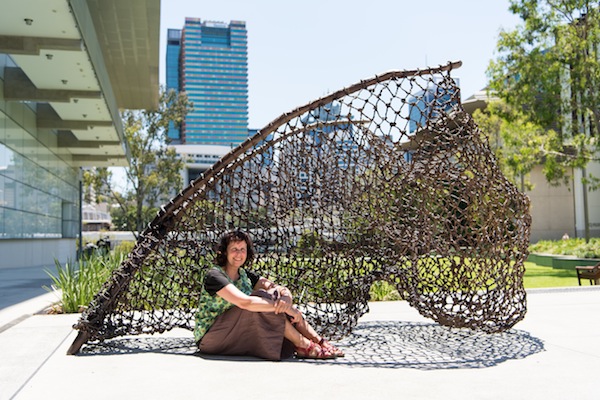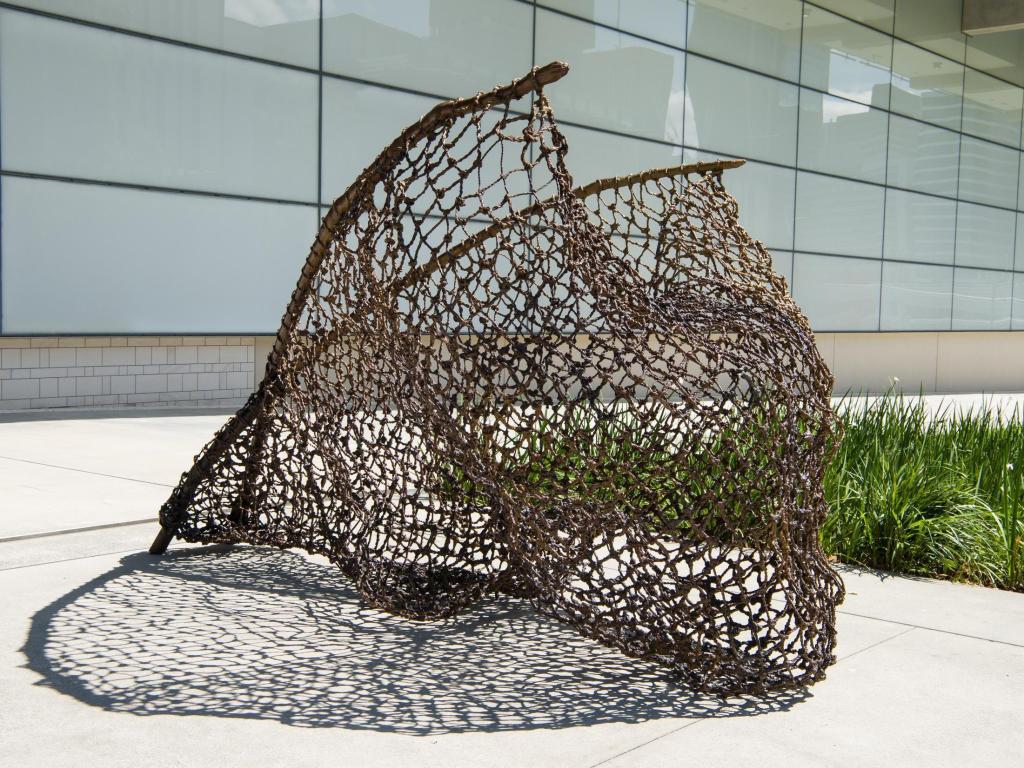Judy Watson’s two row (2016), bronze; commissioned by Gallery of Modern Art, Brisbane; courtesy the artist
Birthdays and anniversaries are often marked with a symbolic object, something that has a legacy well beyond the party.
The Gallery of Modern Art (GOMA) birthday present is the commissioning of Waanyi artist Judy Watson to create a public artwork that will be positioned at the gallery’s entrance.
Watson has created a bronze sculpture titled tow row inspired by the traditional woven fishing nets of South-east Queensland’s Aboriginal communities.
Watson welcomed the Indigenous public commission as a fitting way for visitors to begin a visit to the gallery. ‘I think it is really important that there is an Indigenous presence to the viewer as they come to GOMA and the cultural precinct. It is very timely that this commission has gone ahead – it is an important recognition.’
Based on an everyday object that was an integral tool in the lives of people who fished the banks of Brisbane River and Maiwar Green, the artwork references the land on which it sits and acknowledges the traditional owners of the site and the wider region.
‘It is also on an Aboriginal walking path, which I think of as a bloodline – an indelible lifeline,’ said Watson of the site. ‘My idea was to pull those concealed histories out of the ground and up into view of the visitor.
‘It will be an indicator that Kurilpa Point is a very important spiritual place and, in a very ethereal way, an education resource.’
Watson worked with the young Indigenous artist Leecee Carmichael to research and recreate the cast net from archival material in the Queensland Museum and State Library of Queensland.
She explained: ‘While it is about remaking these things, it is also about making them in new ways. The string used for the sculpture was made with cotton jersey and raffia, allowing it to be pinned and shaped to ensure the sculpture had no hand entrapment issues, while the raffia brought in texture.’
The form was then cast in bronze by the Brisbane-based company Urban Art Projects (UAP).
‘The net is almost like a veil – a spider’s web – that you can see through it and down to the river.
‘I wanted it to look almost as if it has been bought out of the water, so it is a living form not slummed or discarded, and therefore evoke a living presence of Aboriginal people in this area. It is a process of cultural retrieval,’ Watson told ArtsHub.
Watson has designed the sculpture so that people can interact with it. ‘The more people handle and touch the bronze material the more those marks will go into the bronze and add to the tarnish and change the look of the work over time.
‘I love the idea that it will also carry the memory of all those people being part of it – a bit like “Chinese whispers”, where those stories are passed on; are reacted to, and then shared,’ said Watson.
‘I want them to feel the presence of Aboriginal culture, history and memory and to engage with that because it is not just something from the past but something made right now,’ said Watson.
During the opening weekend the broader community joined Judy Watson in a string-making workshop.
‘You go away with a lighter heart and filled with something special – making does that to you,’ she said.

Judy Watson with her sculpture at the entrance to GOMA, Brisbane; supplied courtesy the artist
The GOMA Indigenous Public Art Commission was selected by QAGOMA Director Chris Saines and Indigenous Australians including historian and anthropologist Michael Aird, QAGOMA Curator of Indigenous Australian Art Bruce McLean, architect Kevin O’Brien and Gallery board member Avril Quaill.
It has been realised with the generous support from the Queensland Government, the Neilson Foundation and Cathryn Mittelheuser, AM, through the QAGOMA Foundation.
tow row was unveiled on 2 December, and will be on display permanently at GOMA.





